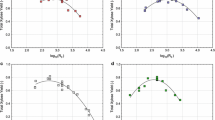Abstract
The purpose of the current study is to optimize the batch reactor performance model using multiple regression analysis for saponification of ethyl acetate by sodium hydroxide. Reaction temperature, reactor volume, agitation rate and reactants initial concentration were the main parameters examined including their interaction effect. Selected process response was the reaction conversion with respect of NaOH. Regression analysis was used to screen out the insignificant factors and the reaction temperature and volume were found to have insignificant effect on the response at the 5% selected significance level (α = 0.05). As a result of multiple regression analysis, agitation rate and reactants concentration were found to be significant operating parameters. The dependence of reaction conversion (response) on agitation rate and concentration was explained by a second order polynomial model and it was concluded that regression model with second order polynomial was good enough to fit the experimental data. The maximum conversion (99.5%) was obtained under optimum operating conditions of agitation rate (70 rpm) and reactants concentration (0.05 M) as evident from surface contours.
Similar content being viewed by others
References
Montgomery, D.C., Design and Analysis of Experiments, New York: John Wiley and Sons, 1991, pp.270–569.
Zivorad, R.L., Design of Experiments in Chemical Engineering, Weinheim: Wiley-VCH, 2004.
Carr, J.M. and McCraken, E.A., Chem. Eng. Prog., 1960, vol.56 (11), pp. 56–61.
Asprey, S.P. and Macchietto, S., Comput. Chem. Eng., 2000, vol. 24, pp. 1261–1267.
Keyvanloo, K., Towghi, J., Sadrameli, S.M., and Mohamadalizadeh, A., J. Anal. Appl. Pyrolysis, 2010, vol. 87, p. 224–230.
Bursali, N., Ertunc, S., and Akay, B., Chem. Eng. Process., 2006, vol. 45, pp. 980–989.
Zofia, V.L., Comput. Ind., 1998, vol.36, pp. 279–300.
Atkinson, A.C., Bagacka, B., and Bogaki, M.B., Chemom. Intell. Lab Syst., 1998, vol. 43, pp.185–198.
Mata-Segreda, J.F., J. Am. Chem. Soc., 2002, vol. 124 (10), pp. 2259–2262.
Ortiz, M.I., Romero, A., and Irabien, A., Thermochimica Acta, 1989, vol. 141, pp.169–180.
Garu, M.G., Nougues, J.M., and Puigjaner, L., 2002. Chem. Eng. J. 88, pp. 225–232.
Danish, M., Al Mesfer, M.K., and Rashid, M.M., Int. J. Eng. Res., 2015, vol. 5(2), pp.74–78.
Kuheli, D., Sahoo, P., Saibaba, M., Murali, N., and Swaminthan, P., Int. J. Chem. Kinet., 2011, vol. 43, pp.648–656.
Mukhtar, A., Shafiq, U., Khan, A.F., Qadir, H.A., and Qizilbash, M., Res. J. Chem. Sci., 2015, vol. 5(11), pp. 46–50.
Schneider, M.A. and Stoessel, F., Chem. Eng. J., 2005, vol. 115, pp.73–83.
Tsujikawa, H. and Inoue, I., Bull. Chem. Soc. Jpn, 1966, vol. 39(9), pp.1837–1842.
Theodorou, V., Skobridis, K., Tzakos, A.G., and Ragoussis, V., Tetrahedron Lett., 2007, vol. 48, pp. 8230–8233.
Wijayarathne, U.P.L. and Wasalathilake, K.C., J. Chem. Eng. Process Technol., 2014, vol. 5(6), pp. 1–8.
Ahmad, A., Ahmad, M.I., Younas, M., Khan, H., and Shah, M.H., Iran. J. Chem. Chem. Eng., 2013, vol. 32(4), pp. 33–44.
Ullah, I., Ahmad, M.I., and Younas, M., Pak. J.Eng. & Appl. Sci., 2015, vol. 16, pp. 84–92.
Li, H., M. Ying., Li, Xingang., and Gao, X., Chem. Eng. Res. Des., 2016, vol.111, pp. 479–491.
Al-Mesfer, M., Int J. Chem. Reactor Eng., 2017. doi: 10.1515/ijcre-0174
Walker, J., Proc. R Soc A, 1906, pp. 78, pp. 157–160.
Author information
Authors and Affiliations
Corresponding author
Additional information
The text was submitted by the authors in English.
Rights and permissions
About this article
Cite this article
Al Mesfer, M.K., Danish, M. & Alam, M.M. Optimization of Performance Model of Ethyl Acetate Saponification Using Multiple Regression Analysis. Russ J Appl Chem 91, 1895–1904 (2018). https://doi.org/10.1134/S1070427218110228
Received:
Published:
Issue Date:
DOI: https://doi.org/10.1134/S1070427218110228




